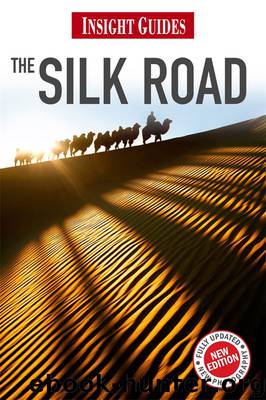Insight Guides: Silk Road by Insight Guides

Author:Insight Guides
Language: eng
Format: epub
Tags: Travel, Asia
Publisher: APA
The Islam Khoja Minaret.
Tony Halliday/Apa Publications
Beside the madrassa is a glowering statue of al-Khwarizmi (783–840), the brilliant Khorezmian mathematician after whom the word “algorithm” is named (he is also considered the father of algebra – another Arabic word, al-jabr). Khwarizmi was born in Khiva but spent much of his working life in Baghdad.
Outside the madrassa is the bright green stub of the Kalta Minor, commissioned by Amin Khan to be the world’s tallest minaret, but abandoned as too costly after the khan was murdered three years later. It is consequently rather squat in appearance.
To the left is the Kukhna Ark, the oldest core of the original fortress, whose roots stretch back some 1,500 years. The complex is notable for ice-blue tilework and tall aiwans that face north to catch the prevailing summer breezes. The royal rooms include a summer mosque, mint, harem and a throne room where the khan would meet winter guests in a felt yurt erected on a brick base (the yurt was easier to heat than the draughty brick halls of the palace). The Ak Sheikh Bobo citadel offers fine views from the roof. Just outside the Ark is the zindon, or city jail.
To the east is the Muhammad Rakhim Khan Madrassa (1871), now home to a crafts centre. A museum is dedicated to the khan, who was also known for his poetry, written under the name Feruz Shah. Feruz was the last khan of Khiva. An interesting figure, his notable achievement was to bring the khanate’s first telephone from St Petersburg, with little thought to the fact that there was no telephone line for hundreds of miles in any direction.
One of Khiva’s holiest sights is the Pakhlavan Mahmud Mausoleum, which commemorates the poet, wrestler and patron saint of Khiva who died here in 1325. The 19th-century tomb contains some of the city’s best tilework and also the largest cupola in Khiva. The Soviets spent years trying to dislodge the cult of Khiva’s local pirs (holy men), but the spot is still madly popular with pilgrims and wedding parties who come here for blessings.
Opposite the tomb is the Madrassa of Shir Ghazi Khan, built with the sweat of 5,000 Persian slaves who, sensing that their promised freedom was not forthcoming, lynched the unfortunate khan inside his new building. The inscription on the portal reads stoically, “I accept death at the hands of slaves.”
Khiva’s tallest minaret, the 45-metre (148-ft) Islam Khoja Minaret, is named after the enlightened early 20th-century grand vizier who built several public schools and hospitals before being assassinated by outraged religious conservatives. Built in 1908, it is the last Islamic monument to be built in the city before the arrival of the Soviets. The attached madrassa hosts the city’s best museum, featuring some wonderful silk clothing amongst the other applied arts.
If the heat is getting too much, dive into the deliciously cool gloom of the nearby Juma Mosque (1788), supported by a dense forest of 213 wooden pillars that are cleverly arranged to allow the entire congregation a view of the mihrab (niche pointing the direction to Mecca).
Download
This site does not store any files on its server. We only index and link to content provided by other sites. Please contact the content providers to delete copyright contents if any and email us, we'll remove relevant links or contents immediately.
China Rich Girlfriend by Kwan Kevin(3890)
The Silk Roads by Peter Frankopan(3758)
Annapurna by Maurice Herzog(2839)
Hot Thai Kitchen by Pailin Chongchitnant(2808)
Full Circle by Michael Palin(2768)
Okonomiyaki: Japanese Comfort Food by Saito Yoshio(2389)
City of Djinns: a year in Delhi by William Dalrymple(2135)
The Ogre by Doug Scott(2113)
Photographic Guide to the Birds of Indonesia by Strange Morten;(2087)
Tokyo by Rob Goss(2015)
Vietnam, Cambodia, Laos & Northern Thailand by Lonely Planet(2011)
Tokyo Geek's Guide: Manga, Anime, Gaming, Cosplay, Toys, Idols & More - The Ultimate Guide to Japan's Otaku Culture by Simone Gianni(1945)
Discover China Travel Guide by Lonely Planet(1864)
Everest the Cruel Way by Joe Tasker(1825)
China (Lonely Planet, 11th Edition)(1796)
Lonely Planet China(1751)
China Travel Guide by Lonely Planet(1739)
Top 10 Dubai and Abu Dhabi by DK Travel(1715)
Iranian Rappers And Persian Porn by Maslin Jamie(1709)
